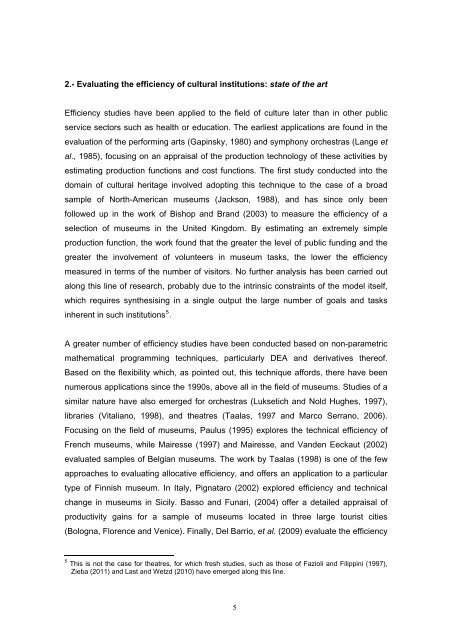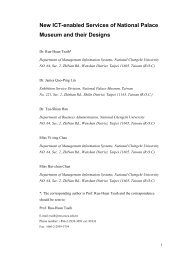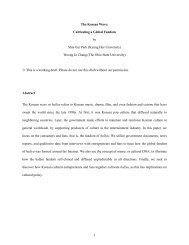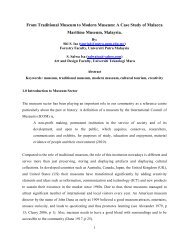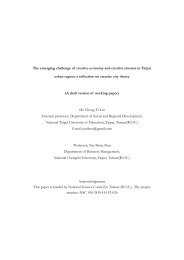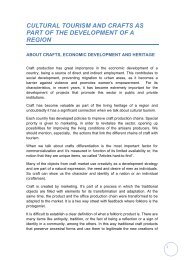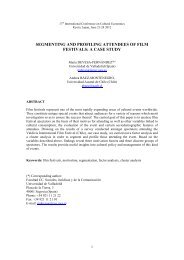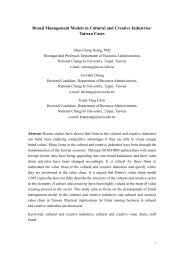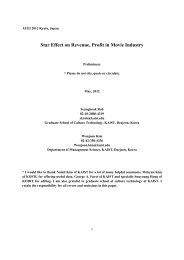Evaluating the efficiency of museums using multiple outputs
Evaluating the efficiency of museums using multiple outputs
Evaluating the efficiency of museums using multiple outputs
You also want an ePaper? Increase the reach of your titles
YUMPU automatically turns print PDFs into web optimized ePapers that Google loves.
2.- <strong>Evaluating</strong> <strong>the</strong> <strong>efficiency</strong> <strong>of</strong> cultural institutions: state <strong>of</strong> <strong>the</strong> art<br />
Efficiency studies have been applied to <strong>the</strong> field <strong>of</strong> culture later than in o<strong>the</strong>r public<br />
service sectors such as health or education. The earliest applications are found in <strong>the</strong><br />
evaluation <strong>of</strong> <strong>the</strong> performing arts (Gapinsky, 1980) and symphony orchestras (Lange et<br />
al., 1985), foc<strong>using</strong> on an appraisal <strong>of</strong> <strong>the</strong> production technology <strong>of</strong> <strong>the</strong>se activities by<br />
estimating production functions and cost functions. The first study conducted into <strong>the</strong><br />
domain <strong>of</strong> cultural heritage involved adopting this technique to <strong>the</strong> case <strong>of</strong> a broad<br />
sample <strong>of</strong> North-American <strong>museums</strong> (Jackson, 1988), and has since only been<br />
followed up in <strong>the</strong> work <strong>of</strong> Bishop and Brand (2003) to measure <strong>the</strong> <strong>efficiency</strong> <strong>of</strong> a<br />
selection <strong>of</strong> <strong>museums</strong> in <strong>the</strong> United Kingdom. By estimating an extremely simple<br />
production function, <strong>the</strong> work found that <strong>the</strong> greater <strong>the</strong> level <strong>of</strong> public funding and <strong>the</strong><br />
greater <strong>the</strong> involvement <strong>of</strong> volunteers in museum tasks, <strong>the</strong> lower <strong>the</strong> <strong>efficiency</strong><br />
measured in terms <strong>of</strong> <strong>the</strong> number <strong>of</strong> visitors. No fur<strong>the</strong>r analysis has been carried out<br />
along this line <strong>of</strong> research, probably due to <strong>the</strong> intrinsic constraints <strong>of</strong> <strong>the</strong> model itself,<br />
which requires syn<strong>the</strong>sising in a single output <strong>the</strong> large number <strong>of</strong> goals and tasks<br />
inherent in such institutions 5 .<br />
A greater number <strong>of</strong> <strong>efficiency</strong> studies have been conducted based on non-parametric<br />
ma<strong>the</strong>matical programming techniques, particularly DEA and derivatives <strong>the</strong>re<strong>of</strong>.<br />
Based on <strong>the</strong> flexibility which, as pointed out, this technique affords, <strong>the</strong>re have been<br />
numerous applications since <strong>the</strong> 1990s, above all in <strong>the</strong> field <strong>of</strong> <strong>museums</strong>. Studies <strong>of</strong> a<br />
similar nature have also emerged for orchestras (Luksetich and Nold Hughes, 1997),<br />
libraries (Vitaliano, 1998), and <strong>the</strong>atres (Taalas, 1997 and Marco Serrano, 2006).<br />
Foc<strong>using</strong> on <strong>the</strong> field <strong>of</strong> <strong>museums</strong>, Paulus (1995) explores <strong>the</strong> technical <strong>efficiency</strong> <strong>of</strong><br />
French <strong>museums</strong>, while Mairesse (1997) and Mairesse, and Vanden Eeckaut (2002)<br />
evaluated samples <strong>of</strong> Belgian <strong>museums</strong>. The work by Taalas (1998) is one <strong>of</strong> <strong>the</strong> few<br />
approaches to evaluating allocative <strong>efficiency</strong>, and <strong>of</strong>fers an application to a particular<br />
type <strong>of</strong> Finnish museum. In Italy, Pignataro (2002) explored <strong>efficiency</strong> and technical<br />
change in <strong>museums</strong> in Sicily. Basso and Funari, (2004) <strong>of</strong>fer a detailed appraisal <strong>of</strong><br />
productivity gains for a sample <strong>of</strong> <strong>museums</strong> located in three large tourist cities<br />
(Bologna, Florence and Venice). Finally, Del Barrio, et al. (2009) evaluate <strong>the</strong> <strong>efficiency</strong><br />
5 This is not <strong>the</strong> case for <strong>the</strong>atres, for which fresh studies, such as those <strong>of</strong> Fazioli and Filippini (1997),<br />
Zieba (2011) and Last and Wetzd (2010) have emerged along this line.<br />
5


